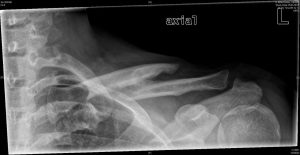Clavicle Fracture
I Sustained A Clavicle Fracture– Do I Need Surgery?
As I have explained in Hindi in this video, vast majority of clavicle fractures will heal by themselves. Furthermore, most patients do not have any functional deficit in the future.
There are some indications where clavicle fracture fixation improves healing and outcomes. These are explained below.
Does An Operation Makes It Heal Quicker ?
How Long Does It Take For A Clavicle To Heal ?
I Am Left With A Bump After The Fracture Healed !
What Factors Should Be Considered When Deciding Whether An Operation Is Needed ?
It has been explained well in this video. Some indications for surgery are:
- Bone ends tenting the skin.
- Significant displacement of bone ends (typically more than 2 cm).
- Multiple displaced fragments.
- Ligament damage along with the fracture.
- Floating shoulder.
Is It A Complex Operation ?
Yes. There are important nerves and blood vessels under the clavicle. These are carefully protected during surgery but there remains a small risk of damage. If that happens it can cause neurological deficit. Other common risks in any fracture fixation include infection, non union, plate prominence etc. Overall risk of these complications is less than 10% in the hands of an experienced surgeon.
If you have any questions, please contact Dr Sarda on +91 774 208 9371 or email shreyamortho@gmail.com.



